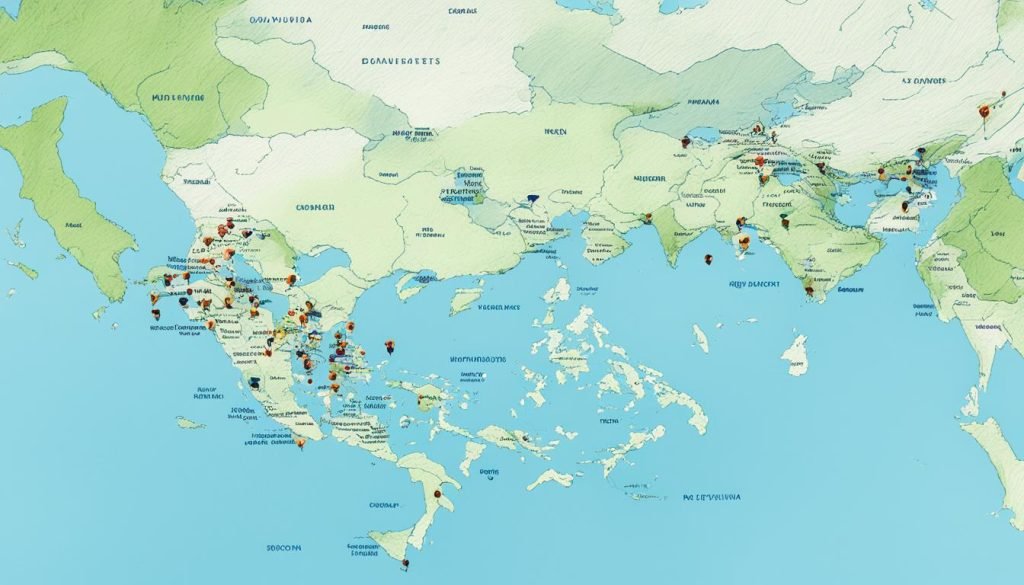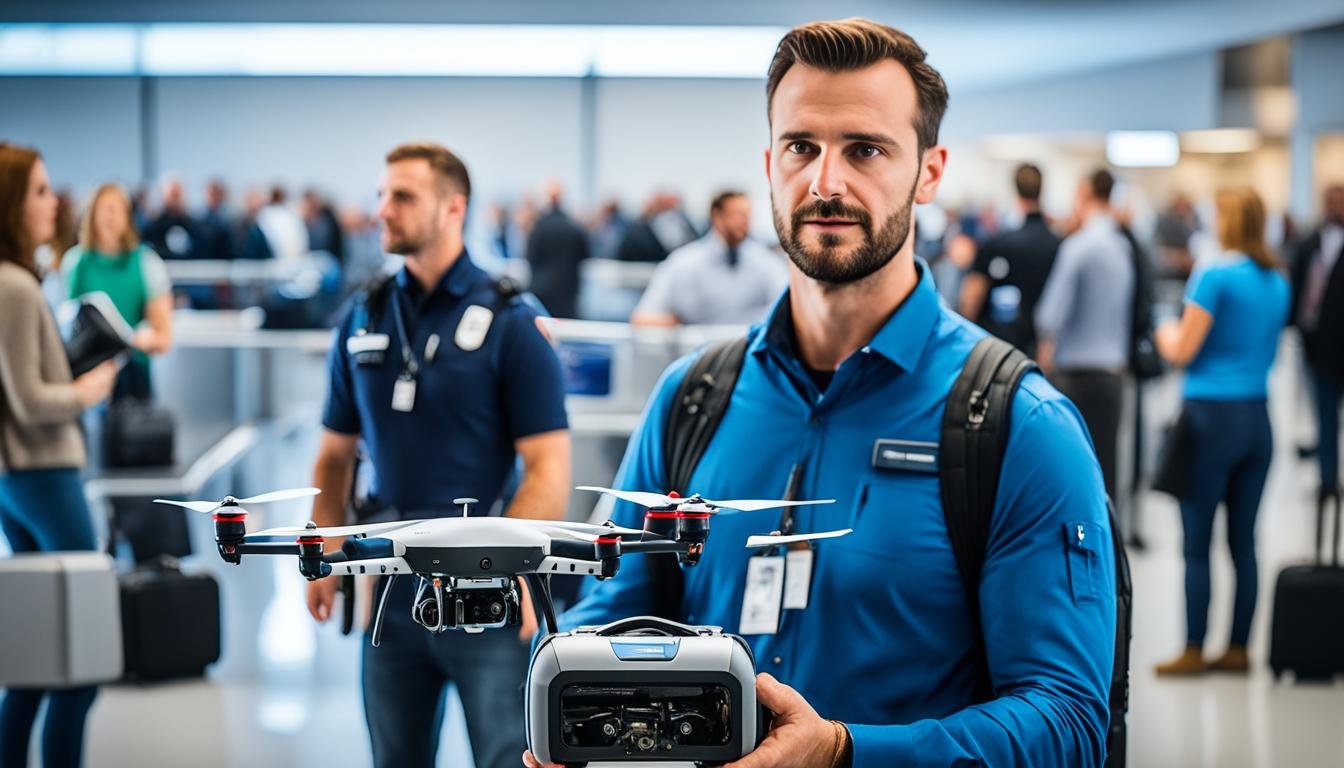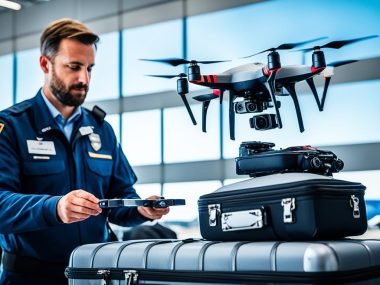With 2.5 million drones expected to fly each year, understanding travel rules is key. Like many drone lovers, I often ponder if my drone can fly with me. Can it stay by my side, or does it have to travel in cargo? The answer is complex. It involves knowing both airline policies and international laws. Let’s explore this together.
Key Takeaways
- Always check with the airline and destination country for specifics on drone travel restrictions.
- Carrying drones in hand luggage is generally advised to prevent loss, theft, or damage.
- Battery restrictions are key when flying with drones—know the rules to ensure safe travel.
- Contacting the local Civil Aviation Authority is a must for up-to-date and accurate guidelines.
- Pre-travel preparation for drone transport is crucial for a smooth journey with no hiccups.
- Keep abreast of changing regulations to avoid surprises and potential penalties.
The Basics of Drone Travel Regulations
Before exploring the skies around the world, I learn about drone travel rules. It’s vital to know these regulations for a smooth journey. Doing so ensures I capture amazing views or enjoy flying without issues.
Understanding TSA Rules for Drones
The TSA’s drone rules are my first check before packing for air travel. Though drones can go through security, TSA officers make the final call. I always check what’s needed, especially about batteries, due to FAA’s strict rules.
Airline-Specific Drone Policies
Each airline has its own rules about drones. That’s why I research my airline’s drone policy ahead of time. Knowing this prevents problems with battery storage at the airport.
Drone Transportation Regulations You Need to Know
Transporting my drone safely is crucial. I pack according to regulations to avoid issues during air travel. This means managing batteries and storing equipment safely, following TSA and airline rules.
Before traveling, I always review the drone flight rules. This preparation stops me from breaking rules and lets me enjoy my adventures.
Preparing Your Drone for Air Travel
As a fan of drones, I’ve learned how crucial it is to pack them right for flights. It’s not just about keeping them safe. It also helps follow strict rules. Knowing how to pack and taking care of drone batteries can ease your trip.
Packing Drones for Carry On Luggage: Do’s and Don’ts
I always prefer to carry my drone in my hand luggage. It lessens the chances of it getting damaged or lost. Make sure the drone is surrounded by protective padding. Keep it away from items that might move and hit it.
Remember, the drone can go in the cabin, but propellers need to be checked in. This keeps you in line with TSA rules. Here are some tips I always use:
- Wrap the drone in bubble wrap or put it in a drone case.
- Take apart any parts that can be removed and pack them separately.
- If you can, take the battery out of the drone to store it alone.
- Don’t pack any loose gear that might turn the drone on.
- Watch your carry-on closely since drones get extra attention during screening.
Handling Drone Batteries Safely
Batteries can be risky because they might catch fire. To avoid trouble, I use strong safety steps like storing batteries in fireproof Lipo bags. I also follow what each airline says. Here’s what to do:
- Put batteries in a fireproof Lipo bag to cut down fire risks.
- Tell TSA agents about your drone and its batteries at the check.
- Carry spare batteries in your hand luggage; don’t check them in.
- Put tape over battery connectors to prevent short circuits.
Here’s a simple table to check when packing drone batteries:
| Battery Handling Task | Best Practice |
|---|---|
| Storage during flight | Use fireproof Lipo bags, carry in hand luggage |
| Notifying security | Inform TSA about batteries during checks |
| Spare batteries | Keep in carry-on; do not check in |
| Protection from short circuits | Insulate terminals, especially if loose |
Drone Security Check: What to Expect
Traveling with tech gadgets often means going through a drone security check. It sounds tough but is actually easy, especially if you know what’s coming. When traveling with flying drones in hand luggage, the process is smooth.
At TSA, I don’t take my drone out of its case. Telling TSA agents about my drone ahead of time helps a lot. This step makes the check quicker and reduces extra inspections. It helps both me and the TSA make things fast and easy.
I carry a laminated sheet with TSA’s rules for LiPo batteries. This proves my gear follows flight rules if there’s a question. Being ready like this has made my drone security check experiences smoother.
If you’re new to flying with drones in hand luggage, I have some advice. These tips have made my trips better:
- Secure your drone’s batteries in fireproof Lipo bags.
- Cover the terminals to avoid shorts. This keeps you safe and meets TSA rules.
- Carry your drone and gear, like batteries and controllers, in carry-on baggage. This guards against damage or loss compared to checked bags.
By following these guidelines, you make your travel easier. You also respect drone security check rules. This makes your drone travel fun and stress-free, as it should be.
Lithium Battery Restrictions and Drone Power Sources
For those flying with drones, knowing about lithium battery rules is key. Following FAA rules is important for safety and compliance. If you’re carrying spare lithium batteries, be aware of the guidelines to avoid issues while traveling.
Flying with Drones: Understanding Battery Capacity
Drones are often powered by lithium batteries because they’re efficient and last longer. But, there are strict rules for air travel with these batteries. Usually, a drone battery cannot be more than 100 watt-hours. This rule helps prevent risks like fires from short circuits or overheating.
Always check your drone’s battery watt-hour rating to follow the rules. You can find this info on the battery or in the manual. If your battery is over 100 Wh, you’ll need to get airline approval beforehand. Sorting this out early avoids problems when you fly.
Federal Aviation Administration (FAA) Battery Guidelines
The FAA sets important rules for carrying lithium batteries safely. You must keep spare lithium batteries in carry-on bags, not checked luggage. This rule helps the crew manage emergencies since they can’t get to the cargo hold in flight. So, remember, packing batteries in your checked bags is not allowed.
My own experience with following these FAA rules has been positive. I always check with my drone’s manufacturer and the airline before flying. It’s smart to ask the airline about any extra battery rules they have. They sometimes have stricter policies than the FAA.
Whether it’s your first time flying with a drone or you’re experienced, good preparation matters. Following FAA and lithium battery rules makes your travel smooth and safe.
International Drone Travel: Navigating Foreign Regulations
Being an avid drone fan has shown me how crucial it is to know the drone travel restrictions. It’s not only about packing your drone right. You must understand the legal issues that you will face abroad. Every country’s aviation laws and regulations can be very different, affecting everything from where you can fly to whether you need permits, or if bringing your drone is allowed at all.
In some places, drones are welcomed but controlled, while in others there are strict rules or even complete bans. Travelers are often surprised by these harsh rules. For example, I once took my drone to a place known for its beautiful cliffs without knowing I needed a special permit. By doing my research, I managed to avoid big fines and losing my drone for breaking the law.
Here is a table showing the differences in drone travel restrictions you might find:
| Country | Permit Required | Flying over Populated Areas | Night Flying | Insurance |
|---|---|---|---|---|
| France | Yes, for commercial use | Prohibited | Prohibited | Yes |
| Japan | Yes, for specific areas | Regulated | Allowed with permission | Not mandatory |
| Canada | Yes, for drones over 250g | Restricted | Prohibited without a waiver | Yes |
| Mexico | Not for recreational use | Allowed with caution | Prohibited | Advisable |
My advice? Do your homework well. Contact the aviation authority in the country you’re visiting to know the rules for international drone travel. This is about following the law and respecting the different cultures we visit.
“When in Rome, do as the Romans do,”
This saying is true for flying drones just like when walking around.
The last thing we want is trouble with the law when trying to get those amazing views. So, get informed, fly safely, and enjoy the freedom of international drone travel.
Drone Transportation Best Practices
In my drone travel experiences, following best practices is key to keeping your drone safe. It’s important to take steps beforehand to prevent damage and delays. By doing so, your drone will arrive in the same state it left. Here, I’ll share tips on securing your drone for flight upon arrival.
Ensuring Your Drone’s Safety in Transit
My top tip is to always carry your drone in your hand luggage. Checked bags can be mishandled, putting your drone at risk. Protecting it from bumps and temperature changes is crucial. This also cuts the risk of theft or loss.
Also, ensure batteries comply with airline rules. Lithium-ion batteries, common in drones, need careful handling to avoid hazards. Keep them in fireproof bags and cover terminals with tape. Staying within airline watt-hour limits avoids security problems.
Tips for Avoiding Damages and Delays
Preparation can reduce travel delays, in my experience. A laminated list of TSA battery rules helps during security checks. When packing, I keep my drone and spares handy to easily show them if asked. This organization can speed up inspections.
- Always use protective cases designed for drones and their accessories.
- Maintain a checklist that aligns with drone transportation best practices for pre-flight packing.
- Be aware of local regulations at your destination to prevent legal entanglements.
Successful drone transport comes from careful planning and sticking to best practices. This ensures drone safety and a smooth journey. Follow these guidelines to enjoy your drone adventure without worries.
“Are Drones Allowed In Carry On Luggage?”— Airlines’ Responses
Travelers often wonder if they can bring drones in carry-on luggage. The short answer is yes, but there are important rules that differ by airline. Knowing these rules is crucial, especially for drones with cameras. Since carry-on size and weight limits vary, check these details early to avoid trouble at check-in.
Dimension and Weight Constraints for Carry On Drones
Many airlines, like American Airlines, accept drones as carry-on baggage, but only if they fit certain size and weight limits. These rules help ensure your drone won’t overload the plane. Always confirm your drone’s size with the airline before you fly to make sure it’s allowed.
Special Rules for Drones with Cameras
Drones with cameras can get extra attention at the airport. Airlines worry about privacy and misuse. To ease concerns, disconnect your drone’s camera if you can. Remember, each airline may have its own rules for carrying drones with cameras.
| Airlines | Max Dimensions (inches) | Max Weight (pounds) | Camera Drone Policy |
|---|---|---|---|
| American Airlines | 22 x 14 x 9 | NA | Allowed, with restrictions |
| Delta Air Lines | 22 x 14 x 9 | NA | Camera must be detached |
| Southwest Airlines | 24 x 16 x 10 | NA | Transport allowed, use restricted |
My suggestion? Always check the latest airline policies for smooth travels. Though drones are usually allowed in carry-on luggage, specific rules about batteries and cameras must be followed. Being prepared and aware of these rules is key to a stress-free journey.
Travelling with Drones to Countries with Strict Regulations
Drones are now popular for taking aerial photos and exploring from the sky. But, if you are planning to take your drone on a trip abroad, you should know the drone travel restrictions and countries with drone bans. If you don’t follow these rules, you might get fined or lose your drone.
Let’s look at places with tough rules and what you need to know to follow them.

- Nicaragua: There are strict rules. Tourists often can’t bring drones without a special permit.
- Morocco: Drones are banned. They will be taken at customs and not returned.
- Fiji: You must get approval from Fiji’s Civil Aviation Authority before you fly there.
- Zambia: You need to get permission from the national aviation authority, even just for fun.
- Cuba: Bringing and using drones is highly restricted. It’s hard to get a permit for non-business reasons.
- Saudi Arabia: You need a permit. But use is often limited to certain areas and reasons.
- Egypt: If your drone isn’t registered, it might be taken. Getting permission is tough.
- India: Drone use is closely watched, especially in sensitive areas for security reasons.
- Kenya: The rules are strict. Tourists without the right permits can face serious consequences.
If you’re going to places known for drone travel restrictions, doing your homework is key. Reach out to the local aviation authority to understand how to get permits and follow their rules. Being a responsible drone user means respecting the laws of countries with drone bans. This helps ensure a smooth trip and shows the positive side of using drones worldwide.
Conclusion
Traveling with my drone is about more than loving flying cameras. It needs careful planning and understanding laws. Knowing TSA’s drone rules and how to pack drones for flights is key for smooth trips. By preparing carefully, my gear stays safe, and I follow flight laws.
Flying drones in other countries is complex. It mixes the thrill of new shots with following strict rules. I learn about each country’s drone laws to avoid trouble. This extra effort ensures my trips go well and keeps my legal record clean.
I’ve made safety and rules a big part of every journey. Whether I’m flying home or abroad, I check all rules on batteries and pack drones in my carry-on. By sharing what I’ve learned, I help other drone fans. We can all enjoy flying without breaking rules if we stay informed.







